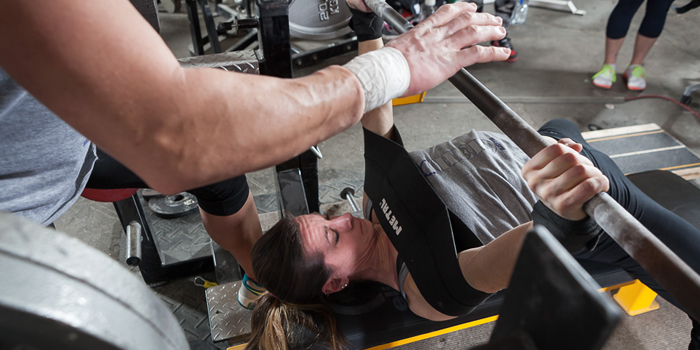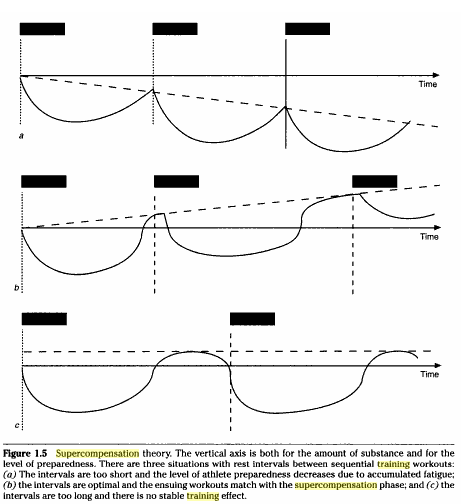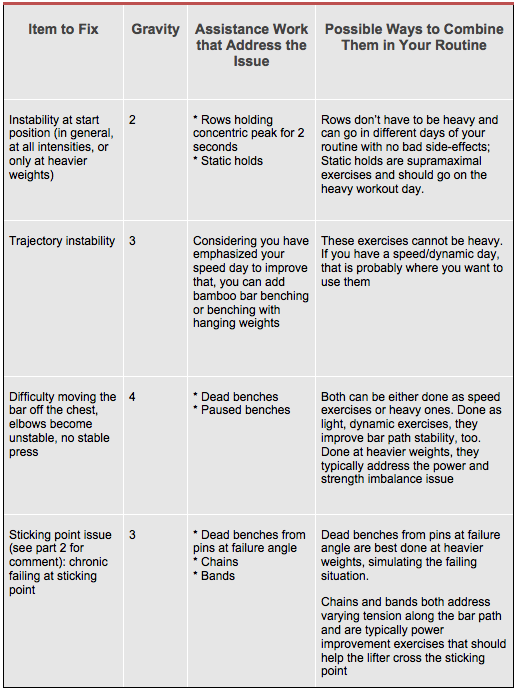
This is the third and last part of this series on how to fix your bench press. Let us start by repeating one of my half a dozen favorite sayings in powerlifting coaching: “if it ain’t broke, don’t fix it.” This said, understand that this series is not about teaching the bench press or offering a new protocol; it is about solving a problem or several problems.
Therefore, in the first part, I addressed setup issues that could be a problem and could be fixed. In the second part, I focused on execution issues that could fix under-performance.
It will not be different here: this is NOT an article about programming. For God’s sake, no! It is about programming issues that may result in underperformance or disaster.
1. Programming
Inhibition, Supercompensation and the CNS Overtraining
The chief programming mistake that can kill your bench press is not programming. There is a famous quote that most of us read in periodization books or even coach blogs: “Failing to plan is planning to fail.” It is attributed to Benjamin Franklin, who was then quoted by Winston Churchill, but there are versions of that going back to Confucius.
The bench press version of this is “let’s keep going,” meaning every week maxing out. Just like any obvious nutrition advice, like “avoid too much sugar and trash food” may have better results for an obese person, in quantitative terms, than the most highly evidence-based dieting plan for an athlete, any training is better than no training for an untrained practitioner. That is how the problem starts: the person learns how to bench, it feels great, every week he/she is stronger, and he/she maxes out. Why not? It feels good and it is fun. Besides, the undeniable fact is that he/she is getting stronger.
RECENT: How to Fix Your Bench Press: The Setup
Until one day there is no improvement. From that day to the day when what used to be an easy (75-80%) weight sinks into his chest and stays there for good, it is a question of one to a few weeks.
After being freed from the immobile bar on his chest by workout buddies or spotters (worst case scenario: this happening at a meet), the horrified lifter gets up and counts the weight on the plates. He can’t believe it. There has to have been a misloading. Someone made a huge mistake and loaded the bar with an extra 100 pounds. But no. He counts again and the weight is exactly his attempt.
“But I repped this for three!” says the distraught lifter to me. “When?” I ask. “Last week! And the week before!”
There you go. A few times, I’ve been able to sit down with the lifter and analyze his training. Some can remember how long they had been maxing out EVERY week, some can’t even recall that — they’ve been doing it forever.
This disastrous underperformance phenomenon has been called for decades “Central Nervous System Overtraining." This is powerlifting jargon: it’s an expression for a very real phenomenon. There is, however, no evidence that it is either CNS related nor a typical overtraining. This is a topic for a different article, but the limited evidence there is to dramatic decreases in maximal strength due to frequent maxing outs points to peripheral (not central) issues 1,2,3,4.
What matters to you, though, is that we know for sure that this results from no programming. The typical benching day when boys gather, warm-up randomly and increase the weight until failure or almost failure.
RECENT: How to Fix Your Bench Press: The Execution
There are a couple of very good training philosophies or methodologies that were simplified by coaches into a “do it yourself” system. Honestly, you don’t need to hire the best coach in the world to avoid disasters like I have described. What all good program systems have in common is that training is either done at submaximal intensities for most of the cycle or higher intensities are rotated, for a certain lift, between exercises (something known as conjugation).
The rationale underlying both strategies is to manage inhibition and optimize supercompensation. Without getting into the details of how this works, every training stimulus produces a compensatory response. The first stage of the compensatory response is always inhibition; it is a response to the stress provided by the training stimulus. After reaching maximal inhibition, the organism recovers and, if timing and intensity are good, recovery brings the organism to a higher performing homeostasis (fig 1).
Figure 1: The Supercompensation Curve
(From Zatsiorsky & Kraemer 2006) 5
The first thing you need to understand about fixing your bench press in terms of programming is that regardless of the methodology you adopt, adopt it and stick to it. I can guarantee that it will not make you max out every week, resulting in the situation of the first curve in the figure.
Last, there is a quote I believe every powerlifter needs to know: “every lifter is born with a certain number of maxes. Why waste them at the gym?” This was said by Ed Coan, the GOAT (greatest of all time).
- Do not max out every week.
- Whatever program or methodology you adopt, adopt it and don't mix it with anything else.
- Leave your maxes for the platform.
Speed Work Is Not For Speed
The second thing you need to understand is that most coaches will organize their programs including some "speed work." The traditional Westside Barbell system is based on a strength day and a speed day for each lift. Other programs will do it differently, will call the smaller periodization sub-unit a micro-cycle, a block, a micro-block, a week — it really doesn’t matter (actually it does, but not for our purposes). Usually, in each smaller subunit, both the higher intensity component of the training (strength day) and the lower intensity will be addressed.
You might be confused because powerlifting is typically a maximal strength sport where movement velocity is either constant or varies at the slower range. So why do you need a speed day if you are going to move weights slowly?
For two reasons: one is that power, or dynamic strength, has carry over to maximal strength 6,7,8. So, yes, you want to develop your ability to move weights fast, or powerfully. The second reason is that you can only perfect your technique and address your form or technique issues doing it with lighter weights and fast enough to produce automation (became “automatic” - see part 1).
- Do your speed work diligently trying to create the most power in each movement.
- Do your speed work movements with excellent technique.
Assistance or Accessory Work Is Not Workout Ornament
The words "assistance” and “accessory” are synonyms; accessory means “something that assists.” The assistance work is introduced into a routine and in a program for some reason. In pre-made programs, usually the author creates the best possible rationale for the assistance exercises, but if you pay attention, the reason an assistance exercise is in the routine, at that point of the periodization, is one of the following:
- It is an important assistance work for that stage of the competitive preparation. Example: supra-maximal work. No matter how beautiful and perfect your form, execution, and programming are, you probably want to do some supramaximal work at some point of your preparation because it serves a certain purpose: increase stability to handle maximal weight. But obviously you don’t want to do supra-maximal weight every week all year long.
- It is important in a stage of your learning curve. Your coach may decide that doing front squats is complementary to learning to squat. He may have his reasons for this
- Preventing or dealing with an injury. This is frequently the most important reason for an assistance exercise for older lifters: there are so many chronic injuries accumulated along the years that many exercises in the routine are there to handle those.
- (Finally!) Fixing a problem. Let’s say we observe the lifter has little control, strength, or difficulty in creating acceleration at the lift-off stage from chest. We can use dead benches or paused benches.
It is important that you understand that no assistance exercise is a universal magic bullet. The “add 50 pounds to your bench press doing this incredible exercise” is always a scam.
What is the best way to handle assistance exercises? Knowing what they do for your lift and introducing them at the right time. An assistance exercise, done at high intensity, may be used in conjugation systems as the chief “strength work” of that day.
An interesting idea is to make an inventory of the issues that need fixing and the assistance exercises that address those issues. Introduce them sequentially. A bad idea is to introduce many (more than two specific movement exercises) in a single session at high intensity. Very bad idea.
Here is an example of how to choose your assistance work (read the description of the exercises below and you can use the same rationale):
- Choose your assistance work according to the weakness to be addressed or the issue to be improved.
2. Assistance Exercises
This is partial list of assistance exercises that can be used for fixing issues with your bench press. Use them wisely. There are many, many others. Good coaches often demonstrate them and you can find them in their books, websites, etc. That is the good side of social media: you can find descriptions and demonstrations from good coaches with a level of detail that would not be possible without hypermedia. The bad way to look for assistance work is look at video that claims to be one, looks fun, or promises to add 50 pounds to your bench press and do it, regardless of who is authoring it. Again, use judgement and reason.
They are divided into the following classes:
- For proper stability
- For movement consistency
- For power
- Supra-maximal work
- Full range of movement with elastic assistance (slingshot-type equipment)
- Hypertrophy work
I just invented these classes to organize the assistance work, so please don’t think this is any consensus in the scientific literature or even the coaching community. There will be some discussion in each item, especially about the supra-maximal work, where I feel it touches the post-activation potentiation issue, so I will offer some information on that. About hypertrophy work, it is basically mentioned so that you know it is assistance work, but I won’t list any. That’s a topic for a whole new article.
A. For Proper Stability
Bamboo Bars and Hanging Weights
Bamboo bars and hanging weights are bar arrangements where the bar is extremely unstable. With the bamboo bar, the bar itself is flexible and creates instability. Hanging weights (from chains or from bands) can be used both on bamboo bars or regular bars, also creating instability.
Having to control these unstable arrangements improves the stability response from the lifter under normal lifting conditions. The exact mechanism by which that happens is unknown, like most of what we mention here.
Below is a video of Louie Simmons demonstrating a “true” bamboo bar bench press. Observe that the bar bends; it is made of flexible material. Below is a video of me benching with hanging weights.
The principle is the same: create instability. It is much more effective with a combination of a flexible bar and hanging weights.
Westside Barbell video:
Me with a regular bar with hanging weights (chains and bands):
Rows and Rows Holding Concentric Peak
Rows are a must in the lives of benchers, not only to build a strong upper back capable of sustaining scapular adduction and depression under maximal weight, but to become highly conscious of it. I like to combine rows with holding the concentric peak for a couple of seconds. This isometric action might have a carry-over to the isometric action needed for the entire duration of a bench press.
In the video below, Jeremy Hoornstra demonstrates a very interesting variation of rows for the bench press.
Hyperextension Holding Concentric Peak
The principle is similar to the rows. They are actually rows, but done with hyperextension: grab a bar or a pair of dumbbells, go to a hyperextension equipment, and pull as you hyperextend. Just like the rows with concentric peak holds, you can to this with hyperextension rows.
B. For Movement Consistency
By “movement consistency” what I mean is that your bench—in all its phases—is sufficiently automated and strength imbalances corrected that it looks pretty much the same every time you execute it, that the velocity and bar path are controlled, and it is overall fluid.
Close and Open Grip Benching
Close grip benching is not problematic. It has been done forever as a triceps exercise. We are beyond that approach at this point. Nevertheless, close grip is an important assistance exercise that might become crucial if the weakness to be solved is the lockout.
The wide grip is more or less the opposite: training wide grip benching makes your regular grip benching more consistent at the liftoff phase. It is also helpful if you are adjusting to a wider grip for your regular bench press.
Below you have two videos where Jeremy Hoornstra demonstrates close grip benching (alone and with boards).
Greg Panora performs a maximal effort close grip bench press in the video below. Close grip benching can be used both as a maximal effort exercise or a speed one.
Finally, I demonstrate the wide grip exercise in the video below with lighter weights, for speed day. With this, you should have a wide variety of options and body types to understand how to employ this assistance work.
Dead Benches
Generating acceleration on a dead weight is always a power exercise. Light dead benches can be used on your speed day for that purpose. Heavier dead benches are meant to address your difficulty with the liftoff from the chest. The bar is set at the pins of a power cage at the height they touch your chest. That is somewhat tricky and frequently requires improvisation (such as using small plates to create the adequate bench height). The weight is pressed from the pins and returned. Wait a few seconds (more than three) to do another rep: the objective is not to benefit from any elastic energy. In the videos below you have Jeremy Hoornstra and myself performing this exercise. As you can see, it can be combined with close or wide grip benching.
Close grip, dead benches for dynamic day: 5X5 up to 150lbs. Notice feet still flat on the ground. After that we did hammer curls and forearm flexor work. #powerlifting #benchpress #assistancework #speedwork #deadbench #dynamic #closegrip #mariliacoutinho #coachericbrown #madpowerlifting #sweatpit A video posted by Marilia Coutinho (@marilia_coutinho) on
Paused Benches
Paused benches also address difficulties with liftoff consistency and power. The pause “kills” the elastic energy effect 9. So you want your pause to last for as many seconds as you need to accomplish that. Research shows that with four seconds you basically have a dead weight.
The big difference between the paused benches and the dead benches is that in the former you must control your stabilizers the whole time, while on the latter it is almost inevitable to lose some stability between reps.
Which is the best? There is no best — both are important. The dead bench requires the lifter to find the groove from scratch and this might be what you need. The paused benches make you hold your stability position at the bottom for a long (yes, it feels like an eternity) time, which improves precisely that: stability.
In the video below, Brandon Tunquist performs a paused bench of 375 pounds.
In this next video, I demonstrate a typical dynamic day exercise where the long pause is followed by a very fast concentric press. Observe that the eccentric phase is deliberately slower, too.
C. For Power
I just mentioned that moving a dead weight develops power. So, shouldn’t the dead and paused benches be in this section? As I said, many assistance exercises assist in more than one issue. In this “power” session I have listed the exercises where there is variation of tension along the bar path: the chains and the bands.
In both, the load is lighter at the chest and tension increases as you approach lockout. Tension varies and you must try to keep the velocity as constant and fast as possible. That should help with sticking point issues and also lockout.
Chains
In the videos below you have Mike Peltz and Dave Tate demonstrating the use of chains for the bench press.
Mike Peltz
Dave Tate
JL Holdsworth gives an excellent explanation about how to adjust the chains.
JL Holdsworth
Bands
Jeremy Hoornstra with a close grip fast band workout .
Swede Burns on bands for speed day and a variation.
Swede with bands on a BUFFALO BAR™ for a heavy effort.
D. Supra-Maximal Work
I am a big fan of supramaximal work for all lifts. The reasons why supramaximal work has such an important carry-over to the full range of motion lift remain uncertain. Some research on post-activation potentiation 10, 11, 12, 13 may shed light on this matter, but if employed wisely, the result is not only increased overall strength on the lift, but more stability. Whether the gain in strength is a side-effect of the stability gain, we don’t know.
Static Holding
Static holds are what the name says: hold the bar for a certain time and rack it back.
- Never, ever do this without assistance. The safest way, actually, is do it out of pins set at the height of your rack supports. Your hand-off people will then just hand the bar off to you, or, alternatively, help you up to the extended arms position.
- How long? Some coaches believe that less than a minute is ineffective. I disagree. As few as 10 seconds may be enough, especially if you are holding the heaviest sets
- How much weight? It varies according to many factors: your own resistance to the supra-maximal weights, your elbow joint health, and if you are raw or equipped. In this series, I am assuming everyone raw for the sake of simplicity. So more than 120% of your maximal weight should be quite enough.
Below you have videos of myself and Hugo Quinteiro using static holds alternated with lighter sets. That is one strategy. Another strategy is to do the static holds as a single workout.
Still going with the "post activation potentiation like" protocol: 190kg (418lb) / 130kg (286lb) - Hugo starting, I was done 🙂 A video posted by Marilia Coutinho (@marilia_coutinho) on
Lockouts from Pins and Boards
Lockout workouts can be done from pins (“deads”) or from boards. The comparison is not much different than the one between dead benches and paused benches: you cannot loosen your stabilizers with a board workout, ever, whereas on the lockouts from pins you actually do loose them at least a little (and then have to find your groove again).
Here you have a video from the Diesel Strength Video Library demonstrating variations of the lockout from pins.
E. Full Range of Movement with Elastic Assistance (Slingshot-Type Equipment)
There are many brands in the market and this article is completely neutral concerning those. Choose whatever works best for you. They are all wide elastic material bands that you can “wear” like half a bench shirt, but much more elastic. They allow you to use maximal or even supra-maximal weights for reps, in full range of motion, which would obviously be impossible otherwise.
It is still unclear exactly how this type of workout carries over to the regular bench press. However, considering this is the only way the lifter will be able to perform controlled repetitions, in full range of motion, with what would be a “max-out”, it is intuitive to suppose this combination is important for the automation of proper technique and strength development.
In the video below, Swede Burns demonstrates a three rep set.
F. Hypertrophy Work
As mentioned before, I will offer no list and no specific comment about hypertrophy work except that it is important assistance work. There is evidence showing a relation between muscularity and performance in powerlifting 12, 13, 14. So, yes, you want muscles. The more, the better.
But you are trying to stay in a lighter bodyweight class! It doesn’t matter; you must optimize for muscularity. Besides, muscles are 80% water. It is much easier for a more muscular lifter to do a water weight cut than a less muscular one.
Another reason to emphasize hypertrophy work is that the exercises are usually much less intense (up to 75%, in general) and do seem to contribute to prevent injuries, although this is not backed by research.
References and Further Reading
- Budgett R, Newsholme E, Lehmann M, Sharp C, Jones D, Peto T, Collins D, Nerurkar R, and White P. Redefining the overtraining syndrome as the unexplained underperformance syndrome. Br J Sports Med 34:67– 68, 2000.
- Fry, Andrew C., Brian K. Schilling, Lawrence W. Weiss, and Loren Z. F. Chiu. _2-Adrenergic receptor downregulation and performance decrements during high-intensity resistance exercise overtraining. J Appl Physiol 101: 1664–1672, 2006.
- Purvis, Physiological and psychological fatigue in extreme conditions: overtraining and elite athletes. PM R. May;2(5):442-50, 2010.
- Hargreaves, M. Fatigue mechanisms determining exercise performance: integrative physiology is systems biology. J Appl Physiol 104: 1541–1542, 2008.
- Zatsiorsky, Vladimir M., and William J. Kraemer. Science and practice of strength training. Human Kinetics, 2006.
- Stone, M.H., K. Sanborn, H.S. O’Bryant, M. Hartman, M.E. Stone, C. Proulx,B.Ward, and J. Hruby. Maximum strength-power-performance relationships in collegiate throwers. J. Strength Cond. Res. 17(4):739–745. 2003.
- Nimphius S1, McGuigan MR, Newton RU. Relationship between strength, power, speed, and change of direction performance of female softball players. J Strength Cond Res: 24(4):885-95, 2010
- Swinton PA1, Lloyd R, Agouris I, Stewart A. Contemporary training practices in elite British powerlifters: survey results from an international competition. J Strength Cond Res: Mar;23(2):380-4, 2009
- Zatsiorsky - Biomechanics in Sport: Performance Enhancement and Injury Prevention. Por Vladimir M. Zatsiorsky, IOC Medical Commission, International Federation of Sports Medicine. Colaborador Vladimir M. Zatsiorsky. Publicado por Blackwell Publishing, 2000 (p. 492).
- Evetovich TK1, Conley DS, McCawley PF. Postactivation potentiation enhances upper- and lower-body athletic performance in collegiate male and female athletes. J Strength Cond Res: 29(2):336-42, 2015
- Lorenz D. Postactivation potentiation: an introduction. International Journal of Sports Physical Therapy: 6(3):234-240, 2011
- Lorenz DS1, Reiman MP. Performance enhancement in the terminal phases of rehabilitation. Sports Health: 3(5):470-80, 2011.
- Docherty D1, Hodgson MJ.The application of postactivation potentiation to elite sport. Int J Sports Physiol Perform: 2(4):439-44, 2007.
- Keogh, JW, Hume, PA, Pearson, SN, and Mellow, PJ. Can absolute and proportional anthropometric characteristics distinguish stronger and weaker powerlifters? J Strength Cond Res 23(8): 2256–2265, 2009.
- Keogh JW, Hume PA, Pearson SN, Mellow P. Anthropometric dimensions of male powerlifters of varying body mass. J Sports Sci: 25(12):1365-76, 2007
- Lovera M, Keogh JW. Anthropometric profile of powerlifters: differences as a function of bodyweight class and competitive success. J Sports Med Phys Fitness: 55(5):478-87, 2015













1 Comment